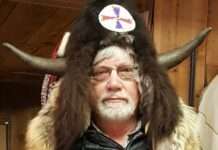In 1998, Connie Storrie, caretaker of the Kansas Wildlife Exhibit at Central Riverside Park in Wichita, was given an orphaned baby bobcat. She named the fuzzy, one week old kitten Bobby and took him home to raise, hoping one day to release him back into the wild. It soon became apparent that Bobby, at such a young age had imprinted on Connie, so he was given a home in the wildlife exhibit at Riverside Park, which over the years has become the home to many injured and wayward animals. The Kansas Wildlife Exhibit has been at Riverside Park since the early 1900’s and was Wichita’s only zoo until the Sedgwick County Zoo opened in 1974. Bobby became somewhat of a celebrity there and shared his home with a skunk, several birds and Chapa the beaver, an escape artist so notorious that his picture was featured on the 2017 Wichita Riverfest poster. Bobby was 20 years old, a ripe old age for a bobcat, and sadly died last month of apparent old age.
………………………………………………………………………………………………………………………………
Anytime now Kansas wild turkeys will be leaving their large winter flocks as gobblers select hens for themselves and break into smaller groups for the spring and summer. When that begins to happen and you start to see strutting tom turkeys, it’s nearly turkey time again! Spring turkey season in Kansas starts with youth and disabled hunters only season from April 1 – April 16, then archery only season April 8 – April 16, and regular firearms and archery season from April 17 – May 31.
I’m not a real seasoned turkey hunter, but I have learned a thing or two, mostly by mistake, about the pursuit of Kansas gobblers. A tried-and-true way of putting yourself on turkeys at first light is to be set up to call them as they leave the roost in the morning. You need to be close, but not too close and you need to be able to get there without being seen or heard by the still-roosted birds. More than once I’ve set up in the morning where I saw birds late the night before and assumed I knew where they roosted, only to be scared spitless the next morning when a big tom gobbled much too near to me in the dark. My error was in not knowing for certain where they roosted and assuming I could come close enough. So if calling birds as they leave the roost in the morning is your game, either stick around long enough the night before or come back after dark and do some coyote howls or owl hoots to know for sure where they are.
Another thing I’ve learned is not to give up too easily on birds you spook. Once spooked, you will probably not get a shot at those birds anymore that day where you happen to spook them, but quietly leave and get set up somewhere ahead of them and the game is still on. A few years ago I built a blind out of brush the landowner had cut at the end of a field a couple hundred yards from where I knew a small group of turkeys was roosting. What I hadn’t planned for were the couple lone jakes roosting by themselves just a short distance from my blind. After they had called my bluff, and the group I knew about had shunned me too, I set up again along a creek just around the corner of the same wooded pasture and started calling. The two jakes that had busted me came running enthusiastically and probably would have run over me had I not shot the first one.
Despite what the pros might say, turkey calling does not have to be precise and flawless either. Yes it’s good to know enough that your calls are not screaming bad things about a gobbler’s mother, but in my opinion it’s much more important to be in the right spot and to be well camouflaged, quiet and still. Turkey season is nearly upon us, so seize this opportunity to harvest yet another Kansas game animal as you continue to Explore Kansas Outdoors.
Steve can be contacted by email at [email protected].



